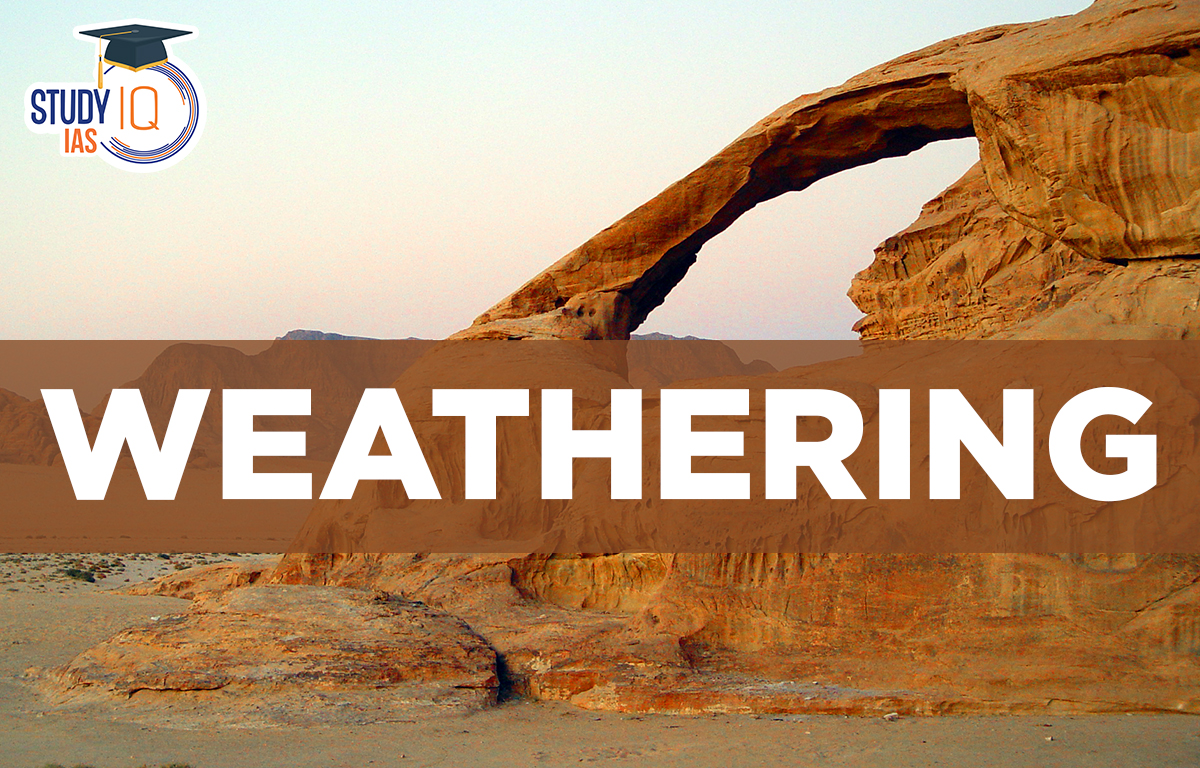Table of Contents
Weathering Definition
Weathering is the process that breaks down rocks and minerals on the Earth’s surface. This can happen due to water, ice, acids, salts, plants, animals, and temperature changes. Once rocks are broken down, erosion moves the small pieces away. No rock can fully resist weathering and erosion, which together shape landscapes like the Grand Canyon. Weathering gradually wears away exposed rock surfaces. Rocks that are buried quickly are less affected than those exposed to wind and water. Weathering also helps create soil by mixing tiny rock particles with organic materials like plants and animal remains.
Weathering Types
Weathering is classified into three types:
All three processes are together found to be in operation. Very rarely does any one of these processes operate independently.
Physical Weathering
Physical weathering happens when temperature changes cause rocks to break apart, often with help from water.
There are two main types:
- Freeze-thaw: Water seeps into cracks, freezes, expands, and breaks the rock.
- Exfoliation: Cracks form parallel to the surface due to reduced pressure from uplift and erosion.
This type of weathering mainly occurs in areas with little soil and few plants, like mountains and hot deserts. It happens through repeated freezing and melting of water or by rocks expanding and contracting in the heat.
Chemical Weathering
Chemical weathering occurs when rainwater reacts with minerals in rocks, creating new materials like clay and soluble salts, especially when the water is slightly acidic. It happens faster in warm, wet climates, which provide the water needed for these reactions, and is the first step in forming soil.
The main types of chemical weathering are:
- Solution: Acidic rainwater dissolves rocks, especially limestone.
- Hydrolysis: Acidic water breaks down rocks into clay and soluble salts.
- Oxidation: Oxygen and water break down rocks, often making iron-rich rocks rusty.
Biological Weathering
Biological weathering happens when living things change the environment by adding or removing minerals and ions, or by causing physical changes as they grow or move. Humans also play a role in this process. When we clear plants, farm the soil, or expose new surfaces, we create new contact between air, water, and minerals. Animals like earthworms, termites, and rats also help by moving soil and breaking down materials.
Read More: Types of Rocks
Weathering of Rocks
Rock near the earth’s surface disintegrates as a result of weathering. The main contributors to weathering are water, air, and plant and animal life. Rock’s surface minerals are loosened and weathered so that erosive forces like water, wind, and ice can carry them away.
Read More: Mass Movement
Weathering Significance
- Weathering is the first step in soil formation.
- Roots can not grow into rocks unless they are weathered.
- Weathering causes erosion, waste, and changes to landforms.
- It produces natural resources like clay for making bricks.
- Weathering makes rocks easier to mine and quarry.
- Vegetation, biomes, and forests depend on weathering.
- Weathering enriches and concentrates ores like manganese, aluminium, iron, and copper.
- Broken rock fragments form sediment, which creates sedimentary rocks like sandstone and limestone.
- Some weathered rocks, like granite tors, become tourist attractions, such as the Bismarck rock in Tanzania.
- Unique weathered rocks can become local shrines for worship.
Difference Between Weathering and Erosion
The processes that reduce rocks to little particles are erosion and weathering. Erosion is the process through which water and wind carry away rock fragments. On the other hand, weathering deteriorates the rocks without moving them.
| Erosion | Weathering |
| It is the shifting of solids caused by ice, water, and wind. | It is the direct atmospheric contact-induced breakdown of minerals, soil, and rocks. |
| Water, wind, ice, thermal, and gravity erosion are the various types of erosion. | Physical, chemical, and biological weathering are among the various types of weathering. |
| Materials that have been eroded are moved. | The deteriorated items are not moved. |
| Among the factors that contribute to erosion are wind, water, ice, and human activity. | Air pressure is one of the atmospheric elements that contribute to weathering. |
Weathering UPSC
The process of wearing down, fracturing, and fragmenting the rock that makes up the surface of the ground and is left out in the elements is referred to as weathering. The process is the outcome of weather-related factors such as frost action, temperature changes, and rain action.
A solid understanding of this subject is required to help individuals pass competitive exams. On that note, we have covered this topic exclusively for students preparing for the UPSC and IAS exams.


 Role of Teachers in Educations, Student ...
Role of Teachers in Educations, Student ...
 India's achievements after 75 years of I...
India's achievements after 75 years of I...
 Bal Gangadhar Tilak Biography, Achieveme...
Bal Gangadhar Tilak Biography, Achieveme...




















